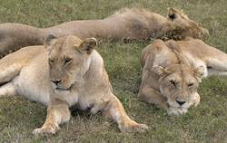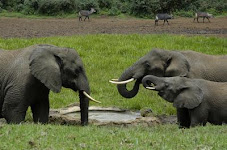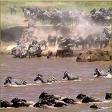
Day 1 – Nairobi - Lake Nakuru National Park
We depart Nairobi and drive down the Escarpment to the floor of the Great Rift Valley to Lake Nakuru National Park for an afternoon game drive. The park covers 180 sq km and is home to warthogs, waterbuck, buffaloes, reedbucks, and the occasional leopard. White and black rhinos were introduced to the park some years ago and you will find white rhino at the southern end. The park has also retained its reputation as an ornithologists’ delight with more than 400 species of bird found here. We spend the night at a Lake Nakuru Guest House inside the park
Day 2: Lake Nakuru - Masai Mara
Depart the camp soon after breakfast and drive via the scenic floor of the Great Rift Valley to Masai Mara. Lunch at a campsite before proceeding for evening gamedrives.Dinner and overnight stay at Mara Campsite
Day 3& 4: Maasai Mara
Full days spent exploring the park in search of the big 5.Morning and afternoon game drives are offered. Optional hot air balloon safari can be arranged at an extra. Dinner and overnight stay at Mara Campsite The Mara offers wildlife in such variety and abundance that it is difficult to believe: over 450 species of animals have been recorded here. You will easily see lions, rhinos, hippos, crocodiles, giraffe, wildebeests, zebras, buffalo, warthogs, hyenas, jackals, wild dogs, buffalo, leopard, many kinds of antelopes and elephant. It is in the Mara that perhaps the most spectacular event of the natural world takes place. This is the annual migration of millions of wildebeest and zebra from the Serengeti (Tanzania) in search of water and pasture. Following on their heels are the predators of the savanna- lion, cheetah, wild dog, jackal, hyena and vultures
Day 5 : Maasai Mara - Musoma
We leave the campsite and drive through the southern part of the reserve viewing game as we proceed to the Tanzanian border at Isebania / Sirari. We stop for the night in a quiet town on the shores of the immense Lake Victoria known as Musoma. The surrounding countryside is home to many different tribes including the Kuria, Jita, Luo, and Taturu. Musoma’s colourful port and variety of tribes make it a vibrant town. Dinner and overnight at Tembo beach hotel
Day 6 : Musoma - Serengeti National Park
Leaving in the morning, we drive south and west to the western corridor of the great Serengeti via Ndabaka Gate with a picnic lunch enroute. The afternoon is spent viewing game and we overnight at a campsite
Day 7 : Serengeti National park
Full day spent exploring the park. Morning and afternoon game drives ate offered. Dinner and overnight stay at a Seronera campsite.The Serengeti National Park is arguably the most impressive wildlife sanctuary in the world. During the months December through March the seemingly unending plains of the southern Serengeti and the Conservation Area are inhabited by enormous herds of wildebeest and zebra. The great herds graze on rain ripened grass. In the calving season (late January through mid March) the herds concentrate at the Ndutu and Salei plains (Southern Serengeti / Ngorongoro Conservation Area) attracting the attention of predators like lion, cheetah and hyena.
Day 8 : Serengeti –Ngorongoro conservation area via Olduvai gorge
We view game as we drive southeast up into the magnificent Ngorongoro Conservation Area .Stop over at The Olduvai Gorge with picnic lunch en route Over at the Olduvai where we spend the night at the Simba (Lion) campsite on the crater rim.
The Olduvai Gorge cuts through rock beds layered in time sequence from 2 million years ago to the present and it is here where humanoid bones have been found dating back to over 1.75 million years including a direct ancestor of modern man. Fossil foot prints (over three million years old) have also been found here and are the most ancient footprints yet discovered. There is an excellent site museum where you can explore the diggings with a guide and it is also a great place to view birds such as the purple grenadier, red and yellow barbet, speckle fronted weaver and slaty colored boubou.
The Olduvai Gorge cuts through rock beds layered in time sequence from 2 million years ago to the present and it is here where humanoid bones have been found dating back to over 1.75 million years including a direct ancestor of modern man. Fossil foot prints (over three million years old) have also been found here and are the most ancient footprints yet discovered. There is an excellent site museum where you can explore the diggings with a guide and it is also a great place to view birds such as the purple grenadier, red and yellow barbet, speckle fronted weaver and slaty colored boubou.
Day9: Ngorongoro - Arusha
Early breakfast then descend into the crater for a full morning crater tour. Lunch then proceed to Arusha. Dinner and overnight stay at Sinka Hotel The Ngorongoro crater is the world’s biggest whole volcanic caldera at 8300 sq km and is arguably the most stunning arena. It is frequently described as one of the wonders of the world, not only because of its geological magnificence, but also because it serves as an extraordinary natural sanctuary for some of Africa’s largest populations of large mammals. Ngorongoro and other freestanding mountains are volcanic in origin, formed during the fracturing process that created the Rift valley 15 to 20 million years ago. When it peaked in size 3 million years ago it was a similar height to Mt. Kilimanjaro today
Day 10 : Arusha -Nairobi
Break fast then board the morning Shuttle bus to Nairobi to arrive by 1400 hrs. Drop off at the airport to board your home bound flight.






